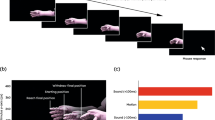Abstract
This study, following a dynamic pattern approach, examines age-related differences in the stability of unimanual rhythmic perception-action patterns. Thirty-six children, aged 7, 9, and 11 years, attempted to synchronize their finger tapping to the beats of an auditory metronome, either “on the beat” (i.e., in-phase coordination), or “off the beat” (i.e., antiphase coordination). The temporal stability of these perception- action patterns was measured by the variability of the relative phase between taps and auditory events and by the critical frequency, that is, the frequency at which a loss of stability was observed when the metronome frequency was increased. Age-related differences in stability were found for both relative phase variability and critical frequency. These findings suggest that the relative phase dynamics underlying perception-action coordination patterns change with age in the direction of an increased temporal stability.
Similar content being viewed by others
Author information
Authors and Affiliations
Additional information
Received: 29 June 1998 / Accepted: 15 December 1998
Rights and permissions
About this article
Cite this article
Volman, M., Geuze, R. Temporal stability of rhythmic tapping “on” and “off the beat”: A developmental study. Psychological Research Psychologische Forschung 63, 62–69 (2000). https://doi.org/10.1007/PL00008168
Issue Date:
DOI: https://doi.org/10.1007/PL00008168




